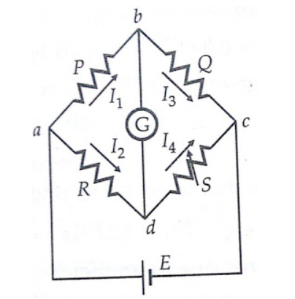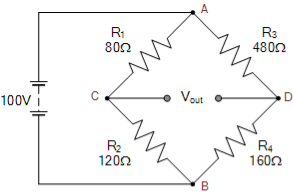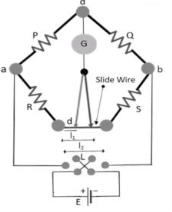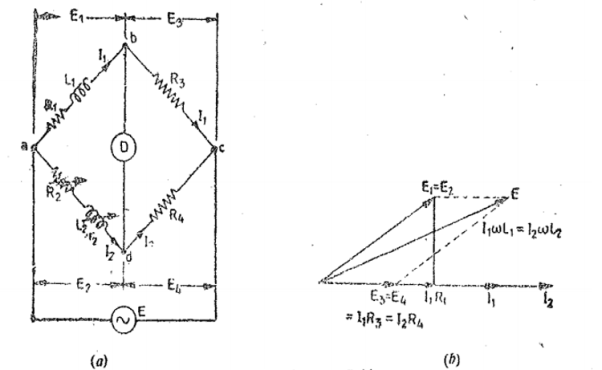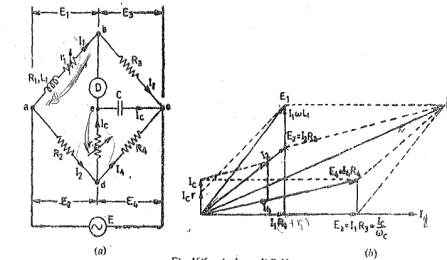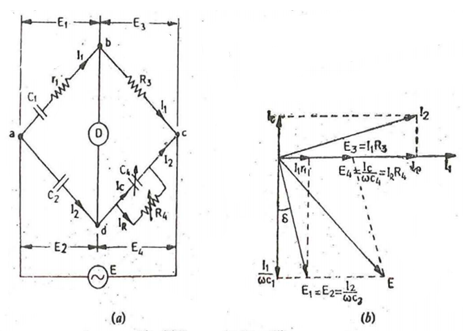|
Derivation The ratio p/q = P/Q, Under the balanced condition current in galvanometer = 0 Potential difference at a & b = voltage drop between Eamd . Eab = [P / P+Q ] Eac Eac = I [ R + S + [( p+q)r] / [p+q+r]] …………(3) Eamd = I [ R + (p / (p+q)) * {(p+q) r / (p+q+r)}] Eac = I [ p r / ( p+q+r)] ………(4) When galvanometer shows zero then (P / P+Q) * I [ R + (p / (p+q)) * {(p+q) r / (p+q+r)} ] = I [ p r / (p+q+r)] R = (P /R)* S + p r / (p+q+r) [ (P/Q) – (p/q)] We know that P/Q = p/q R = (P/Q) * S …….(5) For obtaining perfect results, the arms ratio should be maintained equal and the thermo-electric electromagnetic field induced in the bridge while taking readings can be reduced by interchanging the polarity of the connection. Therefore the unknown resistance value can be obtained from the two arms. |
|
For the first series arm, ACB
Vc = R2/(R1+R2) x Vs
Vc = 120Ω/ 80Ω + 120 Ω x 100 = 60 volts
For the second series arm, ADB
VD = R4/(R3+R4) x Vs
VD = 160Ω/ 480Ω + 160Ω x 100 = 25 volts
The voltage across points C-D is given as:
Vout = VC – VD
Vout = 60 -25 = 35 volts
The value of resistor, R4 required to balance the bridge is given as: R4 = R2R3/R1 = 120Ω x 480Ω/80Ω = 720 Ω |
|
The switch is used to interchange the resistances R and S while testing. The galvanometer records zero when the bridge is balanced. The first bridge balance equation is, P/Q = (R+I1 r)/ [(S+(L+I1) r] Where r = resistance/unit length of the slide wire. Now interchange the resistances R and S. Then the balanced equation for the bridge circuit is given as, P/Q = (S+I2r)/[R+(L-I2)] For the first balance equation, we get, P/Q + 1 = [(R+I1r+ S+(L-I1) r]/[S+(L-I1) r] -------(1) P/Q = (R+S+I1r)/(S+(L-I1) r) We get a second bridge balance equation as P/Q + 1 = [ S + I2 r + R + (L-I1) r] / [R + (L-I2) r] -----------------------------(2) P/Q +1 = (S+ R+ Ir) /(R+(L-I2) r) From the above equations (1) and (2) S + (L-I1) r = R +(L-I1) r S-R = (I1-I2) At the bridge balance condition, the difference between the resistances S and R is equal to the difference of distance between the lengths l1 and l2 of the slide wire. Hence this type of bridge circuit is also called as Carey foster slide wire bridge circuit. |
|
|
Let L1= self-inductance to be measured. R1 = resistance of self -inductor r 1 = resistance connected in series with self-conductor C = fixed standard capacitor R, R2, R3, R4 are known non inductive resistances. At balance I1=I3 and I2=Ic+I4 I2R3 =Ic x 1/jwC Ic = I1jwCR3 Writing the other balance equation I1(r1+R1+jwL1) = I2R2+Icr and Ic(r+1/jw) = (I2-Ic) R4. Substituting the values of Ic in the above equation we get I1(r1+C1+jwL1) =I2R2+I1jwC or I1(r1+R1-jwCR2r) =I2R2 ------(i) And jwCR2 I1(r+1/jwC) = (I2-I1jwcR2) R4 or I1(wCR2r+jwCR3R4+R3) = I2R4—(ii) From (i) and (ii) we get I1(r1+R1+jwL1-jwCR2r) = I1(R2R3/R4+jwCR2R3r/R4 +jwCR3R2) Equating real and imaginary terms R1=R2R3/R1 -r1 And L1=CR3/R4[r(R4+R3) +R2R4 |
|
Let C1 = capacitor whose capacitance is to be determined r1 = series resistance representing the loss in the capacitor C1. C2 = standard capacitor. R3 = non-inductive resistance C4 = variable capacitor R4 = variable non-inductive resistance in parallel with variable capacitor C4. At Balance (r1+1/jwC1) (R4/ 1+jwC4R4) = 1/jwC2. R3 ( r1 + 1/jwC1) R4 = R3 / jwC2 (1+jwC4R4) r1R4 – jR4/wC1 = -jR3/wC2 + R3R4C4/ C2 Equating real and imaginary terms we obtain r1 = C4/C5 xR3 And C1 = R4/R3 x C2 Two independent balance equations are obtained if C4 and R4 are chosen as the variable elements Dissipation factor D1 = tan ɸ = w C1 r1 = w . R4/R3 . C2 . C4/C2 . R3 = wC4R4 |

